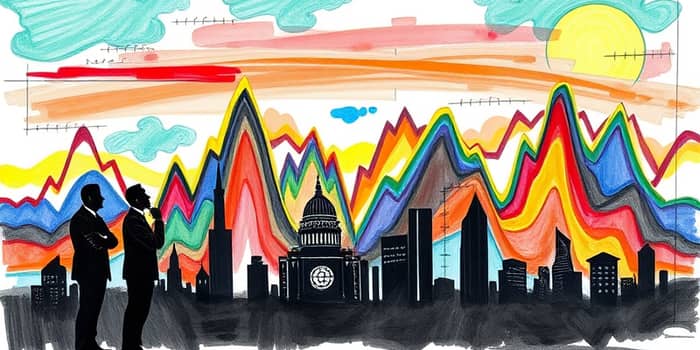Markets can surge, tumble, and rebound with remarkable speed. Understanding volatility is key for investors seeking stability amid uncertainty. This article explores how experts measure volatility, the forces driving market swings, and practical steps to navigate turbulent times. From historical crises to today's rapid shifts, we will uncover the mechanics of rapid and unpredictable price swings and offer guidance to maintain a clear perspective. Whether you are an experienced trader or a long-term saver, these insights will help you turn challenges into opportunities.
Definition and Key Measurements
Market volatility refers to the speed and magnitude of price changes in financial assets. When markets wobble, volatility spikes, signaling uncertainty and risk. This characteristic is present across stocks, bonds, commodities, and currencies. Analysts and traders harness specific tools to decode both historical swings and forward-looking fluctuations.
The CBOE Volatility Index, or VIX, is often dubbed the fear gauge of market sentiment. It estimates the market’s expectation of 30-day S&P 500 volatility. A low VIX suggests calm markets, while a surge indicates that investors foresee larger price moves.
Standard deviation measures the dispersion of past returns around their average. By calculating how far prices have historically fallen or risen, this metric provides insights into an asset’s inherent variability. Higher standard deviation correlates with rapid and unpredictable price swings, requiring extra caution.
The MOVE Index performs a similar function for bond and fixed-income instruments. It aggregates option pricing data to assess the market’s expected movement in Treasury yields. As bonds often serve as a safe haven during turbulent times, elevated MOVE readings can signal broader financial stress.
Collectively, these indicators equip investors with a clearer understanding of potential risks. By tracking changes over days and weeks, market participants can calibrate their strategies to match prevailing conditions.
What Drives Market Volatility?
At its core, volatility is fueled by shifts in information and expectations. When outcomes differ from forecasts, markets adjust—often sharply. Some of the most influential drivers include the following factors, each capable of triggering swift and significant price changes.
Economic data surprises remain prime catalysts. Unanticipated swings in inflation, GDP growth, or employment figures can spur wide market swings as participants reassess valuations. For instance, higher-than-expected inflation may stoke fears of aggressive rate hikes.
Corporate performance announcements also pack a punch. Earnings reports, revenue outlook revisions, and guidance updates can send individual stocks tumbling or soaring. In sectors reliant on tight profit margins, even minor forecast adjustments can amplify volatility.
Geopolitical events cast a broad shadow over global markets. Wars, trade disputes, elections, and policy shifts introduce uncertainty that transcends borders. For example, tariff escalations in 2025 drove the VIX to spikes above 60, reminding investors of heightened global market pressure.
Algorithmic and high-frequency trading further accentuate volatility. These systems execute predefined strategies in milliseconds, reacting to price movements and news headlines. Although they add liquidity, they can also accelerate declines when selling algorithms trigger massive orders.
Investor sentiment and behavior play a pivotal role. Herding tendencies and emotional decisions—driven by fear or exuberance—magnify market moves. Recognizing this human element is essential to avoid being swept up in cyclical extremes.
Historical Episodes and Recent Trends
Periods of extreme volatility have punctuated market history. The Great Depression of the 1930s featured plunging stock prices and systemic banking failures, teaching the importance of financial safeguards. On October 19, 1987—Black Monday—global indices crashed without clear catalyst, pushing the Dow down 22 percent in a single day.
The dot-com bubble, which peaked in 2000, illustrated how speculative fervor can inflate asset classes beyond sustainable levels. Tech stocks plummeted in subsequent years, erasing trillions in market value. In 2008, the collapse of Lehman Brothers and the subprime mortgage crisis precipitated coordinated government interventions and historic stimulus measures.
More recently, the COVID-19 pandemic triggered one of the most violent market selloffs on record. In early 2020, lockdowns and economic shutdowns caused the VIX to exceed 85.5, reflecting unprecedented fear. Massive fiscal and monetary support helped markets rebound within months, highlighting the efficacy of coordinated crisis response.
The period from 2021 through mid-2025 has seen volatility ebb and flow. Average VIX readings hovered around 15–20 in calmer stretches. However, targeted trade tariffs, supply chain disruptions, and shifting inflation expectations have driven episodic hikes. As of July 15, 2025, the average VIX sits at 20.8—above levels seen in all but two of the prior eight years.
This data underscores how external shocks and policy shifts continue to shape daily market dynamics, reminding participants that volatility is both inevitable and cyclical.
Consequences and Investor Psychology
Volatility exerts a profound influence on both market dynamics and investor behavior. In the short term, abrupt price swings can induce anxiety, prompting retail investors to exit positions prematurely. Panic selling during downturns often solidifies losses that might otherwise be recoverable.
Emotion-driven trades can undermine long-term objectives. Studies show that individual investors frequently underperform market benchmarks because they buy high in bull runs and sell low during corrections. Tuning out noise and resisting impulsive reactions allows for calm and disciplined investor behavior.
On the flip side, volatility can create lucrative entry points. Market pullbacks sometimes offer opportunities to purchase quality assets at discounted prices. Investors with cash reserves and a long-term horizon may benefit from history shows markets rebound after shocks, capitalizing on recovery phases.
Understanding the psychological trap of herd mentality helps safeguard against collective overreaction. Cultivating a structured decision-making process—grounded in data and personal goals—mitigates the allure of following the crowd.
The Long-Term Perspective
Over multiple decades, equity markets have historically delivered positive real returns despite periodic downturns. Investors who maintain a consistent strategy—ignoring daily headline noise—tend to achieve better outcomes than those attempting to time the market.
Regular contributions to retirement or investment accounts smooth purchase prices over time, a strategy known as dollar-cost averaging. This approach helps investors avoid the pitfalls of trying to pick exact tops and bottoms, embedding patience into the portfolio management process.
By integrating volatility awareness into long-term planning, individuals can align their risk tolerance and time horizon. Embracing focusing on long-term investment goals ensures short-term turbulence does not derail progress toward milestones like retirement or education funding.
Practical Strategies for Navigating Volatility
Diversification remains the foundation of a resilient portfolio. Allocating capital across asset classes—equities, bonds, real estate, and alternatives—helps offset the impact of severe swings in any one market. Including global exposures further reduces concentration risk.
Risk management techniques, such as hedging with options or employing stop-loss orders, offer additional layers of protection. While these tools incur costs, they can limit downside during extreme events and preserve capital for future opportunities.
Rebalancing portfolios at regular intervals forces the act of selling high and buying low, maintaining target allocations even as asset values diverge. This systematic approach curtails emotional interference in decision-making.
Lastly, establishing a clear investment policy statement—with defined goals, risk parameters, and rebalancing rules—serves as a compass during turbulent markets. Coupled with periodic performance reviews, it fosters consistency and builds confidence in the strategy’s long-term viability prudent and consistent portfolio practices.
Conclusion: Embrace the Ups and Downs
Market volatility is an inherent feature of the financial system. It reflects evolving information, shifting policy landscapes, and collective sentiment. While volatility can be jarring, it also presents a spectrum of opportunities for prepared investors.
By mastering measurement tools, recognizing volatility drivers, and cultivating disciplined risk-management habits, market participants can navigate uncertainty with poise. This strategic approach transforms volatility from a source of fear into a mechanism for growth.
Remember that resilience in investing is built over time. Adopting a long-term mindset, maintaining prudent and consistent portfolio practices, and staying true to your objectives empower you to weather the storms and harness the upside potential in any market environment.
References
- https://www.thrivent.com/insights/investing/market-volatility-what-it-means-and-how-to-manage-with-confidence
- https://www.visualcapitalist.com/charted-the-rise-of-stock-market-volatility-2017-2025/
- https://www.americancentury.com/insights/what-causes-market-volatility/
- https://web.richardsonwealth.com/susan.daley/blog/1936744-Tuning-Out-the-Noise-How-to-Navigate-Market-Volatility-in-2025/
- https://www.torusdigital.com/toruscope/stocks/what-is-market-volatility/
- https://www.diamond-hill.com/insights/a-780/articles/market-volatility-in-2025-tariffs-inflation-and-the-consumer-impact/
- https://www.hennionandwalsh.com/insights/navigating-market-volatility-in-2025-strategies-for-success/
- https://www.etftrends.com/etf-strategist-channel/market-volatility-early-2025-overview/










